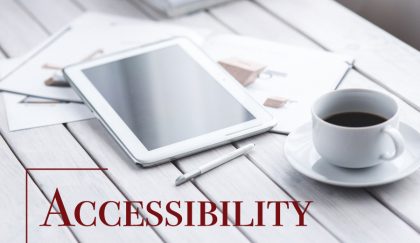Web Accessibility and Web Development

When you sit down to work with a client’s website, do you make sure that every image, embedded media, plug-in, etc. that conveys content has equivalent alternative text?
How about synchronized captions in videos? Or do you let YouTube handle that?
People with disabilities are often an invisible minority. Despite the provisions in the American Disabilities Act, people with disabilities are still dealing with the fact that many public and private organizations do not consider their needs in general…let alone when designing a website.
As of March 2016, at least 61 lawsuits “alleging that a defendant’s inaccessible website violates Title III of the ADA have been filed or removed to federal court.” Title III of the ADA “prohibits discrimination on the basis of disability in the activities of places of public accommodation”. However, many of these legal issues remain uncertain due to delayed regulations and the United States Department of Justice’s own evolving opinions on the issue of web accessibility.
While some may think web accessibility is a minor issue, internet access is more and more crucial in retrieving job applications, product information, public services, and other common needs. People with certain disabilities are often restricted; not by the lack of technology, but by the technology itself.
Section 508
Fortunately, United States federal law has updated to ensure that federally-funded organizations and their websites meet minimum standards of web accessibility. The Reauthorized Rehabilitation Act of 1998 includes Section 508, which requires US Federal agencies to make their electronic and information technology (EIT) accessible to people with disabilities.
Websites, microsites, web pages, apps, and other internet-based tools and services fall under this act.
So how does this affect the process of developing web products? Well, WDG participated in a web accessibility training so we could get to know the latest best practices.
Web Accessibility Methods
The Web Development Group values equal opportunity in the workplace and in our work. A few months ago, our team participated in an in-depth web accessibility training with John F. Cronston III, who runs Accessibility Camp DC and other Accessibility DC events.
One of the main points of interest was how to make a site friendly to screen-readers. Hardcoded images should contain the “alt” attribute, and uploaded images should have the ability to add “alt” to uploaded images. This allows screen-readers to crawl through the code and pull out the necessary information about the images.
Developers also considered tools to make keyboard navigation easier. People with vision impairments or people who are unable to use mouses use tab and other forms of keyboard navigation to navigate interactive features on websites. Accessible keyboard navigation features can include focus indicators as well as correctly organizing navigation order.
Our team was also given resources for keyboard navigation testing and screen-reader testing tools.
While the web accessibility discussion provided a number of insights geared towards what developers can do to build navigation-friendly products, there was also great design feedback. Kristina, one of our designers, noted:
“One difficulty in particular that stood out to me, and am guilty of doing, was subtle changes of colored items on top of one another. Just because I make something 10% darker than another doesn’t mean it’s easily discernible for someone with a vision impairment. If you want someone to click on something, make sure it’s really obvious.”
Putting yourself in someone else’s shoes is an incredibly important user-experience tool. It is also important to consider significant yet often overlooked users. According to World Bank, 15% of the world population experience some form of disability. The internet, and all its resources, is becoming a bigger part of everyone’s day-to-day life. Web designers and developers have an opportunity to make an impact by creating universally accessible products.
A More Accessible Future
You shouldn’t need the threat of a lawsuit in order to create an accessible website. The internet is an incredible open resource and should be a resource for everyone, regardless of ability.
There are many more ways to make your website accessible. While the methods described above are useful, avoid concretizing any particular type of checklist. Recognize that as accessibility technology changes, so should your methods. Regularly check in with organizations tracking web accessibility issues like WebAim, Section508.gov, or here at our blog!
Want to learn more about making your website compliant to the latest web accessibility standards? Contact us!
